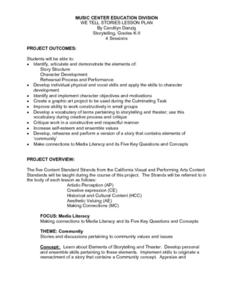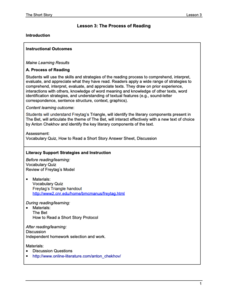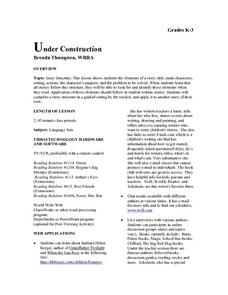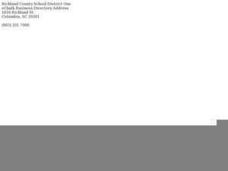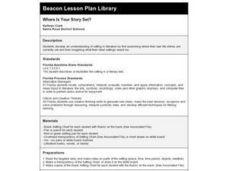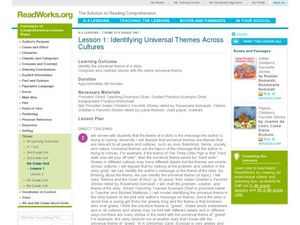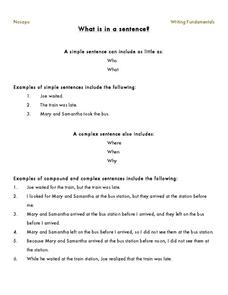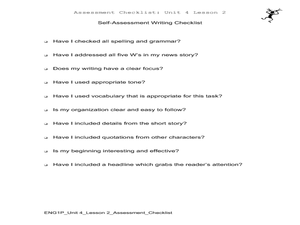Curated OER
We Tell Stories
Young readers bring characters to life by working in small groups to script and perform stories that contain a community concept. Detailed questions and activities are outlined for the class. Consider having your groups create...
Maine Content Literacy Project
The Process of Reading vocabulary, literary elements
Cover Freytag's Triangle and examine Anton Chekhov's "The Bet" in this third lesson plan in a series of fourteen based around short stories. Learners take a quiz and discuss Freytag's triangle. They apply the triangle to "The Bet" and...
Scholastic
Tell Us a Tale: Teaching Students to Be Storytellers
Encourage scholars to retell their favorite short story or folktale, adding personal details to make it their own. After reading their book of choice several times, story tellers retell a tale verbally to their classmates.
Florida Center for Reading Research
Comprehension: Narrative Text Structure, Story Pieces
An activity boosts reading comprehension by challenging scholars to answer questions about a narrative tale detailing elements—plot, characters, setting, theme, problem, and solution.
Curated OER
Twice Upon a Time: Multi-Cultural Cinderella
Engage your learners in a cross-cultural study by having them read, compare, and contrast various Cinderella stories from different cultures around the world. From this exercise, they will learn that plot element can seem different, but...
Curated OER
Under Construction
Young readers examine the elements of story structure that are included in all stories. They include these elements in their own written pieces. This phenomenally-designed plan has everything you need to easily implement it in your...
Curated OER
Sequencing The Three Billy Goats Gruff
First graders participate in sequencing activities. In this sequencing lesson, 1st graders read the book the Three Billy Goats Gruff. Students retell the story and act out the scenes in groups. Students create a mural of the story...
Curated OER
Where Is Your Story Set?
Students explore the concept of setting in literature by identifying their own current setting, and imagining what their ideal setting would be. They read a piece of literature, identify the setting and record the information on a chart.
Curated OER
Theatre Lesson Plan, Performing a Story
Second graders read the story, The Bundle of Sticks, and discuss the story elements within the story; setting, plot, conflict resolution. In this readers theater lesson, 2nd graders reenact the story in small groups, then reflect on...
Curated OER
Teaching a Short Story
Students work in small groups and prepare an analysis of a short story to be presented to their peers. They research the story and create a handout or a visual aid that cites sources of information and summarizes the main points of the...
Curated OER
Building Fiction: Elements of a Short Story
Students define and interpret the elements found in a short story. Then they identify the elements of plot found in a short story. Students also apply knowledge of plot to an original work of fiction. Finally, they identify the...
Curated OER
Telling Stories: Symbols of a Life
Art and literature can go hand in hand, they both are used to express elements of the self in a creative and interesting way. Budding story tellers interpret and analyze the narrative elements they find in a work of art. They focus on...
Pennsylvania Department of Education
Drawing Conclusions Based on Literary Elements
Students compare versions of Cinderella and draw conclusions based on the story elements identified. In this literacy comprehension and story elements lesson, students read several versions of Cinderella, complete a "Comparing Folklore"...
Curated OER
Elements of Messages
Students examine media messages. In this media awareness lesson, students analyze political cartoons and identify the literary elements they incorporate. Students also use the Media Elements Handout to identify the elements in other...
Curated OER
Sequencing / Story Events
Students read a story and use sentence strips to order story events. In this sequencing lesson, students learn new vocabulary words centered around the story Cloudy With a Chance of Meatballs, preview the story, make predictions about...
Curated OER
Fairy Tales
Once upon a time are four words most children are familiar with when reading a fairy tale. But do they know that fairy tales are a great way to learn the literary elements of reading and writing? Use a thorough fairy tale unit to teach...
Curated OER
Identifying Universal Themes Across Cultures
Have your class read the story "The Magic Lake," retold by Liana Romulo, from Filipino Children's Favorite Stories. Guide them to identify the problem, solution, and universal theme. They compare the theme of this story to the theme of...
Nosapo
What Is in a Sentence, Paragraph, and Story?
Language arts is made up of many parts. Learners review the parts of a sentence, as well as how to make a simple sentence into a complex sentence, before examining full paragraphs and identifying the topic, body, and concluding sentence...
Curated OER
"The Story of an Hour" Lesson 3: Teacher's Guide and Notes
The third lesson in "The Story of an Hour" series introduces young readers to analogies; a literary device writers use to add depth to their stories. Instructors identify the three analogies in the tale, and class members consider the...
Curated OER
Who Am I?
Your budding journalists need to understand the five W's for writing a news story. They read a story, complete several graphic organizers to help them organize and write their article, and then use a self-assessment worksheet to edit and...
Curated OER
Printing and Publishing
Explore African literature and artwork in a multicultural literacy and art lesson. Begin with a read aloud of Tiger and the Big Wind: A Tale from Africa, and afterward, have kids retell the main events in the story. They identify and...
Curated OER
Tone and Mood
How are mood and tone similar? Different? Help your readers understand the difference between the two with this helpful guide. On the first page, they read the definition for both tone and mood and identify words that are describe each....
Curated OER
Character Traits
First graders identify the story elements in stories. In this story element lesson, 1st graders read The Tale of Peter Rabbit by Beatrix Potter and they identify the characters, character traits, setting, problem, and solution. They...
Curated OER
Character Cluster
Third graders practice identifying characters and story elements by creating a character cluster in class. In this story analysis instructional activity, 3rd graders discuss the story Snow White and identify the characteristics of the...


